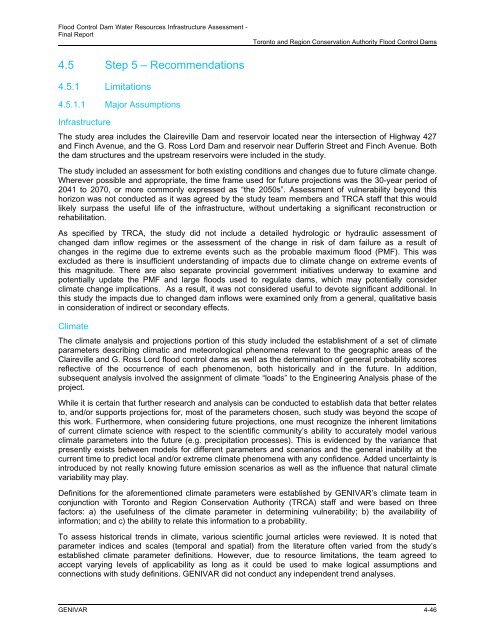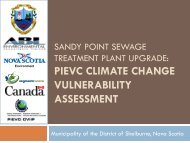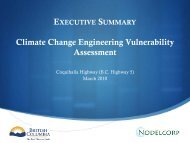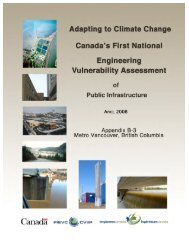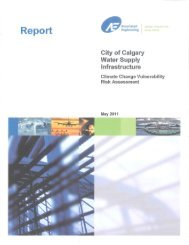Final Report - Vulnerability Committee
Final Report - Vulnerability Committee
Final Report - Vulnerability Committee
You also want an ePaper? Increase the reach of your titles
YUMPU automatically turns print PDFs into web optimized ePapers that Google loves.
Flood Control Dam Water Resources Infrastructure Assessment -<strong>Final</strong> <strong>Report</strong>Toronto and Region Conservation Authority Flood Control Dams4.5 Step 5 – Recommendations4.5.1 Limitations4.5.1.1 Major AssumptionsInfrastructureThe study area includes the Claireville Dam and reservoir located near the intersection of Highway 427and Finch Avenue, and the G. Ross Lord Dam and reservoir near Dufferin Street and Finch Avenue. Boththe dam structures and the upstream reservoirs were included in the study.The study included an assessment for both existing conditions and changes due to future climate change.Wherever possible and appropriate, the time frame used for future projections was the 30-year period of2041 to 2070, or more commonly expressed as “the 2050s”. Assessment of vulnerability beyond thishorizon was not conducted as it was agreed by the study team members and TRCA staff that this wouldlikely surpass the useful life of the infrastructure, without undertaking a significant reconstruction orrehabilitation.As specified by TRCA, the study did not include a detailed hydrologic or hydraulic assessment ofchanged dam inflow regimes or the assessment of the change in risk of dam failure as a result ofchanges in the regime due to extreme events such as the probable maximum flood (PMF). This wasexcluded as there is insufficient understanding of impacts due to climate change on extreme events ofthis magnitude. There are also separate provincial government initiatives underway to examine andpotentially update the PMF and large floods used to regulate dams, which may potentially considerclimate change implications. As a result, it was not considered useful to devote significant additional. Inthis study the impacts due to changed dam inflows were examined only from a general, qualitative basisin consideration of indirect or secondary effects.ClimateThe climate analysis and projections portion of this study included the establishment of a set of climateparameters describing climatic and meteorological phenomena relevant to the geographic areas of theClaireville and G. Ross Lord flood control dams as well as the determination of general probability scoresreflective of the occurrence of each phenomenon, both historically and in the future. In addition,subsequent analysis involved the assignment of climate “loads” to the Engineering Analysis phase of theproject.While it is certain that further research and analysis can be conducted to establish data that better relatesto, and/or supports projections for, most of the parameters chosen, such study was beyond the scope ofthis work. Furthermore, when considering future projections, one must recognize the inherent limitationsof current climate science with respect to the scientific community’s ability to accurately model variousclimate parameters into the future (e.g. precipitation processes). This is evidenced by the variance thatpresently exists between models for different parameters and scenarios and the general inability at thecurrent time to predict local and/or extreme climate phenomena with any confidence. Added uncertainty isintroduced by not really knowing future emission scenarios as well as the influence that natural climatevariability may play.Definitions for the aforementioned climate parameters were established by GENIVAR’s climate team inconjunction with Toronto and Region Conservation Authority (TRCA) staff and were based on threefactors: a) the usefulness of the climate parameter in determining vulnerability; b) the availability ofinformation; and c) the ability to relate this information to a probability.To assess historical trends in climate, various scientific journal articles were reviewed. It is noted thatparameter indices and scales (temporal and spatial) from the literature often varied from the study’sestablished climate parameter definitions. However, due to resource limitations, the team agreed toaccept varying levels of applicability as long as it could be used to make logical assumptions andconnections with study definitions. GENIVAR did not conduct any independent trend analyses.GENIVAR 4-46


